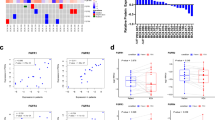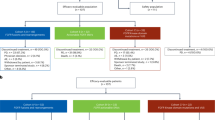Abstract
Somatic alterations of fibroblast growth factor receptors (FGFRs) have been described in a wide range of malignancies. A number of anti-FGFR therapies are currently under investigation in clinical trials for subjects with FGFR gene amplifications, mutations and translocations. Here, we develop cell line models of acquired resistance to FGFR inhibition by exposure of cell lines harboring FGFR3 gene amplification and translocation to the selective FGFR inhibitor BGJ398 and multitargeted FGFR inhibitor ponatinib. We show that the acquisition of resistance is rapid, reversible and characterized by an epithelial to mesenchymal transition and a switch from dependency on FGFR3 to ERBB family members. Acquired resistance was associated with demonstrable changes in gene expression including increased production of ERBB2/3 ligands, which were sufficient to drive resistance in the setting of FGFR3 dependency but not dependency on other FGFR family members. These data support the concept that activation of ERBB family members is sufficient to bypass dependency on FGFR3 and suggest that concurrent inhibition of these two pathways may be desirable when targeting FGFR3-dependent cancers.
This is a preview of subscription content, access via your institution
Access options
Subscribe to this journal
Receive 50 print issues and online access
$259.00 per year
only $5.18 per issue
Buy this article
- Purchase on SpringerLink
- Instant access to full article PDF
Prices may be subject to local taxes which are calculated during checkout






Similar content being viewed by others
References
Dieci MV, Arnedos M, Andre F, Soria JC . Fibroblast growth factor receptor inhibitors as a cancer treatment: from a biologic rationale to medical perspectives. Cancer Discov 2013; 3: 264–279.
Katoh M, Nakagama H FGF receptors: cancer biology and therapeutics. Med Res Revi 2013; 34: 280–300.
Turner N, Grose R . Fibroblast growth factor signalling: from development to cancer. Nat Rev Cancer 2010; 10: 116–129.
Weiss J, Sos ML, Seidel D, Peifer M, Zander T, Heuckmann JM et al. Frequent and focal FGFR1 amplification associates with therapeutically tractable FGFR1 dependency in squamous cell lung cancer. Sci Transl Med 2010; 2: 62ra93.
Hammerman PS, Hayes DN, Wilkerson MD, Schultz N, Bose R, Chu A et al. Comprehensive genomic characterization of squamous cell lung cancers. Nature 2012; 489: 519–525.
Courjal F, Cuny M, Simony-Lafontaine J, Louason G, Speiser P, Zeillinger R et al. Mapping of DNA amplifications at 15 chromosomal localizations in 1875 breast tumors: definition of phenotypic groups. Cancer Res 1997; 57: 4360–4367.
Kunii K, Davis L, Gorenstein J, Hatch H, Yashiro M, Di Bacco A et al. FGFR2-amplified gastric cancer cell lines require FGFR2 and Erbb3 signaling for growth and survival. Cancer Res 2008; 68: 2340–2348.
Turner N, Lambros MB, Horlings HM, Pearson A, Sharpe R, Natrajan R et al. Integrative molecular profiling of triple negative breast cancers identifies amplicon drivers and potential therapeutic targets. Oncogene 2010; 29: 2013–2023.
van Rhijn BW, van Tilborg AA, Lurkin I, Bonaventure J, de Vries A, Thiery JP et al. Novel fibroblast growth factor receptor 3 (FGFR3) mutations in bladder cancer previously identified in non-lethal skeletal disorders. Eur J Hum Genet 2002; 10: 819–824.
Dutt A, Salvesen HB, Chen TH, Ramos AH, Onofrio RC, Hatton C et al. Drug-sensitive FGFR2 mutations in endometrial carcinoma. Proc Natl Acad Sci USA 2008; 105: 8713–8717.
Liao RG, Jung J, Tchaicha J, Wilkerson MD, Sivachenko A, Beauchamp EM et al. Inhibitor-Sensitive FGFR2 and FGFR3 Mutations in Lung Squamous Cell Carcinoma. Cancer Res 2013; 73: 5195–5205.
Chesi M, Nardini E, Brents LA, Schrock E, Ried T, Kuehl WM et al. Frequent translocation t(4;14)(p16.3;q32.3) in multiple myeloma is associated with increased expression and activating mutations of fibroblast growth factor receptor 3. Nat Genet 1997; 16: 260–264.
Chesi M, Brents LA, Ely SA, Bais C, Robbiani DF, Mesri EA et al. Activated fibroblast growth factor receptor 3 is an oncogene that contributes to tumor progression in multiple myeloma. Blood 2001; 97: 729–736.
Singh D, Chan JM, Zoppoli P, Niola F, Sullivan R, Castano A et al. Transforming fusions of FGFR and TACC genes in human glioblastoma. Science 2012; 337: 1231–1235.
Williams SV, Hurst CD, Knowles MA . Oncogenic FGFR3 gene fusions in bladder cancer. Hum Mol Genet 2013; 22: 795–803.
Majewski IJ, Mittempergher L, Davidson NM, Bosma A, Willems SM, Horlings HM et al. Identification of recurrent FGFR3 fusion genes in lung cancer through kinome-centred RNA sequencing. J Pathol 2013; 230: 270–276.
Wu YM, Su F, Kalyana-Sundaram S, Khazanov N, Ateeq B, Cao X et al. Identification of targetable FGFR gene fusions in diverse cancers. Cancer Discov 2013; 3: 636–647.
Lamont FR, Tomlinson DC, Cooper PA, Shnyder SD, Chester JD, Knowles MA . Small molecule FGF receptor inhibitors block FGFR-dependent urothelial carcinoma growth in vitro and in vivo. Br J Cancer 2011; 104: 75–82.
Lemieux S, Hadden MK . Targeting the fibroblast growth factor receptors for the treatment of cancer. Anticancer Agents Med Chem 2013; 13: 748–761.
Andre F, Bachelot T, Campone M, Dalenc F, Perez-Garcia JM, Hurvitz SA et al. Targeting FGFR with dovitinib (TKI258): preclinical and clinical data in breast cancer. Clin Cancer Res 2013; 19: 3693–3702.
Wolf J, LoRusso PM, Camidge RD, Perez JM, Tabernero J, Hidalgo M et al. Abstract LB-122: A phase I dose escalation study of NVP-BGJ398, a selective pan FGFR inhibitor in genetically preselected advanced solid tumors. Cancer Res 2012; 72.
Guagnano V, Furet P, Spanka C, Bordas V, Le Douget M, Stamm C et al. Discovery of 3-(2,6-dichloro-3,5-dimethoxy-phenyl)-1-{6-[4-(4-ethyl-piperazin-1-yl)-phenylamin o]-pyrimidin-4-yl}-1-methyl-urea (NVP-BGJ398), a potent and selective inhibitor of the fibroblast growth factor receptor family of receptor tyrosine kinase. J Med Chem 2011; 54: 7066–7083.
Guagnano V, Kauffmann A, Wohrle S, Stamm C, Ito M, Barys L et al. FGFR genetic alterations predict for sensitivity to NVP-BGJ398, a selective pan-FGFR inhibitor. Cancer Discov 2012; 2: 1118–1133.
Garraway LA, Janne PA . Circumventing cancer drug resistance in the era of personalized medicine. Cancer Discov 2012; 2: 214–226.
Harbinski F, Craig VJ, Sanghavi S, Jeffery D, Liu L, Sheppard KA et al. Rescue screens with secreted proteins reveal compensatory potential of receptor tyrosine kinases in driving cancer growth. Cancer Discov 2012; 2: 948–959.
Herrera-Abreu MT, Pearson A, Campbell J, Shnyder SD, Knowles MA, Ashworth A et al. Parallel RNA Interference Screens Identify EGFR Activation as an Escape Mechanism in FGFR3-Mutant Cancer. Cancer Discov 2013; 3: 1058–1071.
Chell V, Balmanno K, Little AS, Wilson M, Andrews S, Blockley L et al. Tumour cell responses to new fibroblast growth factor receptor tyrosine kinase inhibitors and identification of a gatekeeper mutation in FGFR3 as a mechanism of acquired resistance. Oncogene 2013; 32: 3059–3070.
Sequist LV, Waltman BA, Dias-Santagata D, Digumarthy S, Turke AB, Fidias P et al. Genotypic and histological evolution of lung cancers acquiring resistance to EGFR inhibitors. Sci Transl Med 2011; 3: 75ra26.
Hanahan D, Weinberg RA . Hallmarks of cancer: the next generation. Cell 2011; 144: 646–674.
Engelman JA, Zejnullahu K, Mitsudomi T, Song Y, Hyland C, Park JO et al. MET amplification leads to gefitinib resistance in lung cancer by activating ERBB3 signaling. Science 2007; 316: 1039–1043.
Wilson TR, Fridlyand J, Yan Y, Penuel E, Burton L, Chan E et al. Widespread potential for growth-factor-driven resistance to anticancer kinase inhibitors. Nature 2012; 487: 505–509.
Schlessinger J . Ligand-induced, receptor-mediated dimerization and activation of EGF receptor. Cell 2002; 110: 669–672.
Bublil EM, Yarden Y . The EGF receptor family: spearheading a merger of signaling and therapeutics. Curr Opin Cell Biol 2007; 19: 124–134.
Shien K, Toyooka S, Yamamoto H, Soh J, Jida M, Thu KL et al. Acquired resistance to EGFR inhibitors is associated with a manifestation of stem cell-like properties in cancer cells. Cancer Res 2013; 73: 3051–3061.
Citri A, Skaria KB, Yarden Y . The deaf and the dumb: the biology of ErbB-2 and ErbB-3. Exp Cell Res 2003; 284: 54–65.
Straussman R, Morikawa T, Shee K, Barzily-Rokni M, Qian ZR, Du J et al. Tumour micro-environment elicits innate resistance to RAF inhibitors through HGF secretion. Nature 2012; 487: 500–504.
Barr S, Thomson S, Buck E, Russo S, Petti F, Sujka-Kwok I et al. Bypassing cellular EGF receptor dependence through epithelial-to-mesenchymal-like transitions. Clin Exp Metastasis 2008; 25: 685–693.
Winter SF, Acevedo VD, Gangula RD, Freeman KW, Spencer DM, Greenberg NM . Conditional activation of FGFR1 in the prostate epithelium induces angiogenesis with concomitant differential regulation of Ang-1 and Ang-2. Oncogene 2007; 26: 4897–4907.
Zhang Z, Lee JC, Lin L, Olivas V, Au V, LaFramboise T et al. Activation of the AXL kinase causes resistance to EGFR-targeted therapy in lung cancer. Nature Genet 2012; 44: 852–860.
Cheng T, Roth B, Choi W, Black PC, Dinney C, McConkey DJ . Fibroblast growth factor receptors-1 and -3 play distinct roles in the regulation of bladder cancer growth and metastasis: implications for therapeutic targeting. PLoS ONE 2013; 8: e57284.
Jenndahl LE, Isakson P, Baeckstrom D . c-erbB2-induced epithelial-mesenchymal transition in mammary epithelial cells is suppressed by cell-cell contact and initiated prior to E-cadherin downregulation. Int J Oncol 2005; 27: 439–448.
Lu J, Guo H, Treekitkarnmongkol W, Li P, Zhang J, Shi B et al. 14-3-3zeta cooperates with ErbB2 to promote ductal carcinoma in situ progression to invasive breast cancer by inducing epithelial-mesenchymal transition. Cancer Cell 2009; 16: 195–207.
Kim J, Jeong H, Lee Y, Kim C, Kim H, Kim A . HRG-beta1-driven ErbB3 signaling induces epithelial-mesenchymal transition in breast cancer cells. BMC Cancer 2013; 13: 383.
Abel EV, Basile KJ, Kugel CH 3rd, Witkiewicz AK, Le K, Amaravadi RK et al. Melanoma adapts to RAF/MEK inhibitors through FOXD3-mediated upregulation of ERBB3. J Clin Invest 2013; 123: 2155–2168.
Montero-Conde C, Ruiz-Llorente S, Dominguez JM, Knauf JA, Viale A, Sherman EJ et al. Relief of feedback inhibition of HER3 transcription by RAF and MEK inhibitors attenuates their antitumor effects in BRAF-mutant thyroid carcinomas. Cancer Discov 2013; 3: 520–533.
Moffat J, Grueneberg DA, Yang X, Kim SY, Kloepfer AM, Hinkle G et al. A lentiviral RNAi library for human and mouse genes applied to an arrayed viral high-content screen. Cell 2006; 124: 1283–1298.
Acknowledgements
PSH is supported by NCI K08 CA163677, the V Foundation the Stephen D and Alice Cutler Fund. We thank M Meyerson for assisting with the planning of this study. JW is supported by NSFC 81202746 and CSC.
Author information
Authors and Affiliations
Corresponding author
Ethics declarations
Competing interests
PSH reports consulting fees from ARIAD, ImClone, Janssen and Molecular MD. The remaining authors declare no conflict of interest.
Additional information
Supplementary Information accompanies this paper on the Oncogene website
Supplementary information
Rights and permissions
About this article
Cite this article
Wang, J., Mikse, O., Liao, R. et al. Ligand-associated ERBB2/3 activation confers acquired resistance to FGFR inhibition in FGFR3-dependent cancer cells. Oncogene 34, 2167–2177 (2015). https://doi.org/10.1038/onc.2014.161
Received:
Revised:
Accepted:
Published:
Issue Date:
DOI: https://doi.org/10.1038/onc.2014.161



